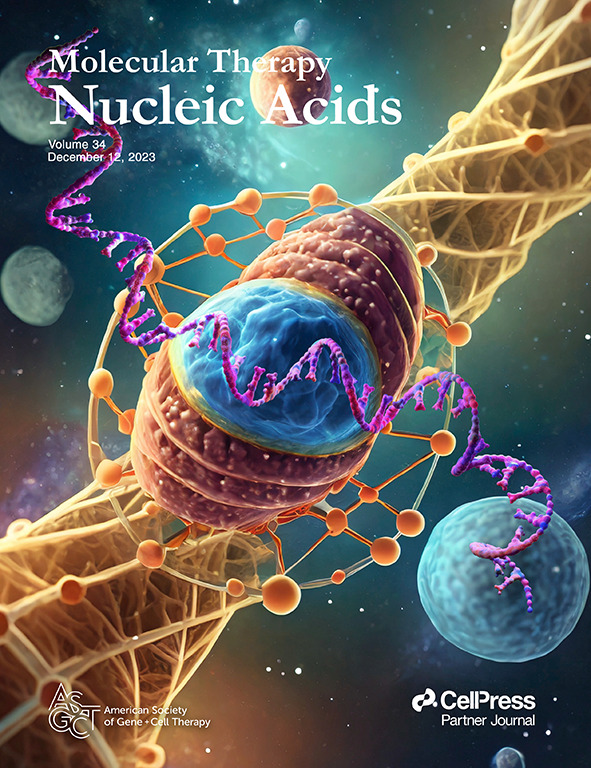双功能 CpG-STAT3 诱饵寡核苷酸引发小鼠急性髓性白血病的多系分化
IF 6.5
2区 医学
Q1 MEDICINE, RESEARCH & EXPERIMENTAL
引用次数: 0
摘要
尽管先天性免疫受体(如 Toll 样受体 9 (TLR9))高表达,急性髓性白血病(AML)细胞仍会抵抗分化刺激。我们以前曾证实,使用 TLR9 靶向诱饵寡核苷酸(CpG-STAT3d)靶向信号转导子和转录激活子 3(STAT3)可增加人和小鼠 AML 细胞的免疫原性。在这里,我们阐明了 STAT3 抑制/TLR9 激活驱动 inv(16) AML 重编程的分子机制。在转录水平上,静脉注射 CpG-STAT3d 或白血病靶向沉默和 TLR9 共同刺激后,从小鼠体内分离出的 AML 细胞显示出类似的髓细胞分化()和抗原递呈()相关基因的上调,同时白血病促进基因的减少。单细胞转录组学显示,CpG-STAT3d 能诱导 AML 细胞多线分化为单核细胞/巨噬细胞、红细胞和 B 细胞亚群。诱导性沉默显示,IRF8 的上调对白血病细胞的单核-巨噬细胞分化至关重要。TLR9驱动的AML细胞重编程可能是通过下调STAT3控制的甲基化调节因子(如DNMT1和DNMT3)实现的。事实上,使用阿扎胞苷抑制DNA甲基转移酶(DNMT)和单独使用CpG寡核苷酸可模拟CpG-STAT3d效应,从而导致AML细胞分化、T细胞活化和全身性白血病消退。这些发现凸显了双功能寡核苷酸的免疫治疗潜力,通过同时抑制 STAT3 和/或 DNMT,释放 TLR9 驱动的白血病细胞分化。本文章由计算机程序翻译,如有差异,请以英文原文为准。
Bi-functional CpG-STAT3 decoy oligonucleotide triggers multilineage differentiation of acute myeloid leukemia in mice
Acute myeloid leukemia (AML) cells resist differentiation stimuli despite high expression of innate immune receptors, such as Toll-like receptor 9 (TLR9). We previously demonstrated that targeting Signal Transducer and Activator of Transcription 3 (STAT3) using TLR9-targeted decoy oligodeoxynucleotide (CpG-STAT3d) increases immunogenicity of human and mouse AML cells. Here, we elucidated molecular mechanisms of inv(16) AML reprogramming driven by STAT3-inhibition/TLR9-activation . At the transcriptional levels, AML cells isolated from mice after intravenous administration of CpG-STAT3d or leukemia-targeted silencing and TLR9 co-stimulation, displayed similar upregulation of myeloid cell differentiation () and antigen-presentation ()-related genes with concomitant reduction of leukemia-promoting . Single-cell transcriptomics revealed that CpG-STAT3d induced multilineage differentiation of AML cells into monocytes/macrophages, erythroblastic and B cell subsets. As shown by an inducible silencing , IRF8 upregulation was critical for monocyte-macrophage differentiation of leukemic cells. TLR9-driven AML cell reprogramming was likely enabled by downregulation of STAT3-controlled methylation regulators, such as DNMT1 and DNMT3. In fact, the combination of DNA methyl transferase (DNMT) inhibition using azacitidine with CpG oligonucleotides alone mimicked CpG-STAT3d effects, resulting in AML cell differentiation, T cell activation, and systemic leukemia regression. These findings highlight immunotherapeutic potential of bi-functional oligonucleotides to unleash TLR9-driven differentiation of leukemic cells by concurrent STAT3 and/or DNMT inhibition.
求助全文
通过发布文献求助,成功后即可免费获取论文全文。
去求助
来源期刊

Molecular Therapy. Nucleic Acids
MEDICINE, RESEARCH & EXPERIMENTAL-
CiteScore
15.40
自引率
1.10%
发文量
336
审稿时长
20 weeks
期刊介绍:
Molecular Therapy Nucleic Acids is an international, open-access journal that publishes high-quality research in nucleic-acid-based therapeutics to treat and correct genetic and acquired diseases. It is the official journal of the American Society of Gene & Cell Therapy and is built upon the success of Molecular Therapy. The journal focuses on gene- and oligonucleotide-based therapies and publishes peer-reviewed research, reviews, and commentaries. Its impact factor for 2022 is 8.8. The subject areas covered include the development of therapeutics based on nucleic acids and their derivatives, vector development for RNA-based therapeutics delivery, utilization of gene-modifying agents like Zn finger nucleases and triplex-forming oligonucleotides, pre-clinical target validation, safety and efficacy studies, and clinical trials.
 求助内容:
求助内容: 应助结果提醒方式:
应助结果提醒方式:


